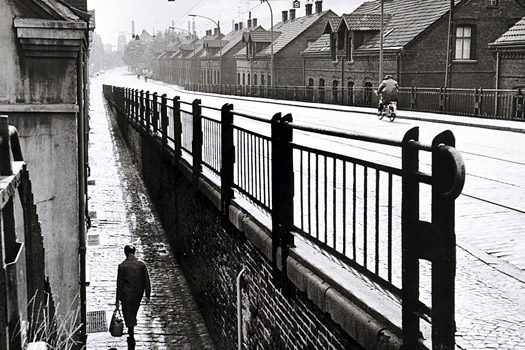
Arbeitsmigration nach Bruckhausen
Der große Bedarf an Arbeitern des Bergwerks „Gewerkschaft Deutscher Kaiser“ ließ im Schatten der Hochöfen einen Vorort entstehen: Hier investierten Privatleute in Arbeiterwohnhäuser als Anlageobjekte. Ein Quartier in dreigeschossig-städtischer Bauweise wuchs heran.
© Stadtarchiv Duisburg
Leute zurück zur Auswahl
The mining suburb, Bruckhausen, and labour migration in northern Duisburg - 130 years of immigration particularly shaped northern areas of the city
From1880 onwards, Bruckhausen, near Ruhrort, changed itself quite radically within just a few decades compared to other cities in the booming Ruhr Region. The small peasant community had barely 250 inhabitants in 1840. The work in Shaft 3 of the “Gewerkschaft Deutscher Kaiser” began in 1889; at the same time the majority stakeholder in the mine, August Thyssen, bought up almost all of Bruckhausen. At the end of 1891, his steel and rolling mill began operation; the heart of which became known as the “August Thyssen Huette”. Its large demand for workers allowed a suburb to develop in the shadow of the furnaces: here, mostly well-to-do local master craftsmen invested privately in residential buildings for workers as investment properties; stores and churches also emerged. Three-story living quarters were constructed, which no longer resembled a peasant community.
The mine specifically recruited people from many different areas across Europe; most workers came from Eastern Prussia. Around 1910 every fourth person thought and spoke in Polish. Each group of immigrants brought with them their culture and religion. In 1904, a prayer house, which is still preserved today, was built for the Evangelical Masurians, in the back courtyard of Reinerstraße 35; this room is once again being used for sacred purposes as the Yildirim-Beyazid Mosque. Since the late 1960s, immigrant Turkish families, who have been dependent on housing close to their places of work, as well as on low-cost housing, have made up the majority of the population. The tearooms and stores owned by Bruckhausen residents of Turkish origin have shaped this section of the city, as did the immigrants from the former Polish areas of Prussia around 1910.
In contrast to the urban Bruckhauser district around Diesel and Reiner streets, the nearby Thyssen works settlements “Jupp Kolonie” and “Dichterviertel” are more likely to be oriented towards rural models. They document the worker settlement construction of the August Thyssen Huette, and its mines, whose creative ideals were incorporated multiple times during those five decades into the style of the time, and during which the settlements were expanded again and again. The settlement’s inhabitants were also shaped by different phases of immigration: here, where prior to 1900, Polish-speaking shops existed, multinational tenants of predominantly Turkish origin now live.
Denkmale zum Impuls
Duisburg - Dichtersiedlung
Das Dichterviertel ist zusammen mit der anschließenden Siedlung Felix-Dahn-Straße ... weiter
Duisburg - Yildirim-Beyazid-Moschee
Bruckhausen bei Ruhrort wurde nach 1880 binnen weniger Jahrzehnte radikaler umgekrempelt als ... weiter
Denkmalbereich Bruckhausen
Bruckhausen bei Ruhrort wandelte sich binnen weniger Jahrzehnte von einer kleinen Bauernschaft ... weiter
Duisburg - Siedlung Josefs-Kolonie
Um 1900 kamen die ersten polnischsprachigen Zuwanderer nach Duisburg-Hamborn. Hamborn ... weiter

